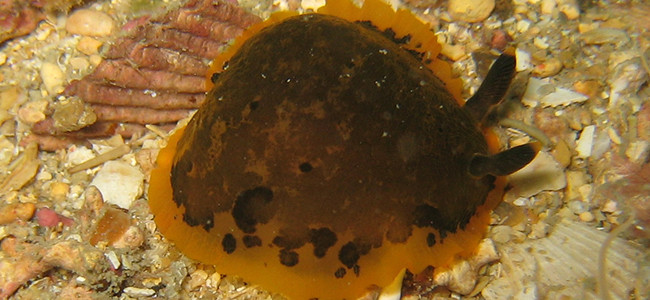Dendrodoris limbata is a nudibranch belonging to the family Dendrodorididae. Its scientific name comes from the Greek, where ‘Dendron‘ means ‘tree‘ and ‘doris‘ refers to the sea nymph from Greek mythology, while ‘limbata‘ alludes to the well-defined edges of the animal’s body. This mollusc is known for its soft, shell-less body characteristic of nudibranchs, and it is primarily distributed in the Mediterranean Sea and the eastern Atlantic, from Portugal to Morocco. It is commonly found on rocky or sandy bottoms in shallow intertidal and subtidal zones, feeding mainly on marine sponges.
Dendrodoris limbata can reach lengths between 4 and 8 cm, though larger individuals have occasionally been recorded. Its body is oval and gelatinous in consistency, lacking an internal skeleton or shell, which makes it very flexible. The coloration of this species varies but generally features dark tones such as black, brown, or gray, often with yellow or orange spots, especially along the mantle edges, helping to distinguish it from similar species. One of its most striking features is the smooth and shiny texture of its body, contrasting with the rougher surfaces of other nudibranchs. The absence of ringed rhinophores, present in other species, is also a distinctive trait. Compared to Dendrodoris grandiflora, Dendrodoris limbata is darker and shows less color variation.
Regarding its diet, Dendrodoris limbata feeds almost exclusively on marine sponges, primarily from the genera Dysidea and Spongia. This feeding behavior is common among dorid nudibranchs, which use their specialized radulae to scrape sponge surfaces and extract nutrients. Through digestion, this species incorporates toxic compounds from its prey, enabling it to accumulate chemical defenses against predators. In fact, the toxins obtained from the sponges not only provide protection but also contribute to its warning coloration—a signal to potential predators that it is toxic or unpalatable.
Reproduction in Dendrodoris limbata is hermaphroditic, as with most nudibranchs. This means each individual possesses both male and female reproductive organs. During mating, two individuals exchange sperm and then both deposit spiral gelatinous egg masses attached to rocks or algae. The planktonic larvae that hatch swim in the water column for some time before settling on the seafloor, where they metamorphose into adults. This life cycle allows for wide dispersal of the species across different areas.
An interesting aspect of Dendrodoris limbata is that, unlike other nudibranchs, it lacks a fully developed radula. This is because its diet consists of soft sponges, which do not require a hard, toothed radula to be consumed. Instead, Dendrodoris limbata secretes digestive enzymes that dissolve its prey before ingestion, a feeding method that distinguishes it from other nudibranchs feeding on harder prey. This unique behavior makes it an ecologically fascinating species, as its specialized diet contributes to the dynamics of sponge populations in its natural habitat.
Photos:

